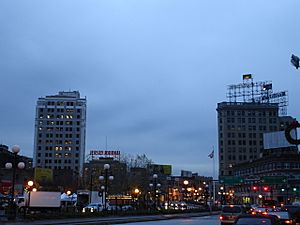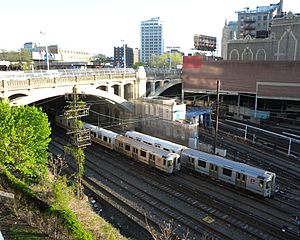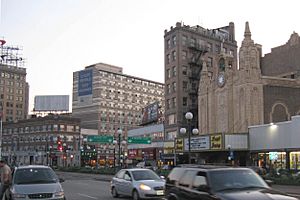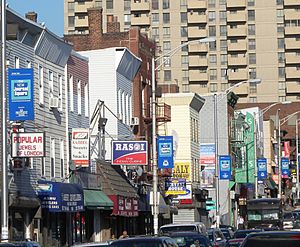Journal Square facts for kids
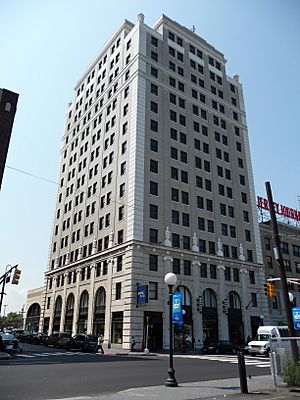
Journal Square is a busy area in Jersey City, New Jersey. It's a place where people live, work, and travel. The area got its name from a newspaper called the Jersey Journal, which used to have its main office there. The "square" itself is where two main roads, Kennedy Boulevard and Bergen Avenue, meet. Many government offices for Hudson County are also located here.
Contents
History of Journal Square
Before it became a busy center, Journal Square was mostly farmland with old houses. These houses belonged to the families who first settled in Bergen in 1660.
In 1912, a new train station opened. Many old buildings were taken down to make way for new ones. Some of these, like the Labor Bank Building, are still standing today.
The actual "square" area was created in 1923. The city removed the Jersey Journal offices to make a wider intersection. The newspaper then built a new headquarters, and the square was named after it.
A bridge carrying the main boulevard was finished in 1926. For most of the 1900s, Journal Square was the main entertainment spot in Hudson County. It had big movie theaters like the Stanley Theater (built in 1928) and the Loew's Jersey Theater (built in 1929). People called Journal Square the "crown jewel" of the city because it was so lively.
The famous song "Jersey Bounce" from the 1940s even mentions Journal Square! In 1960, John F. Kennedy gave a speech here just before he was elected president. The boulevard was later named Kennedy Boulevard in his honor.
The Journal Square Transportation Center opened in the 1970s. It includes the Journal Square PATH train and bus station. This center is built above an old railroad cut from 1834. In front of the station, there is a statue of Jackie Robinson. He was a famous baseball player who broke racial barriers in the sport in 1946.
A statue of Christopher Columbus has been in the square since 1950. The Stanley is now used by Jehovah's Witnesses. The Loew's theater has been restored and is used for movies and other cultural events.
Community and Education
The main campus of Hudson County Community College is made up of several buildings around Journal Square. A few blocks south, you can find Saint Peter's University, Hudson Catholic Regional High School, and the Jersey City Armory.
Many shops run by Filipino and Indian American communities are located along Newark Avenue and near India Square.
County Hub
Northeast of Journal Square is an area called Five Corners. This is where the main government offices for Hudson County are located. The Hudson County Courthouse and the Hudson County Administration Building are here. They house the county's courts and many government departments.
The Five Corners Branch of the Jersey City Public Library is also at this intersection. William L. Dickinson High School is nearby.
New Buildings and Future Plans
Journal Square is seeing a lot of new construction. Many older buildings are being replaced or updated. City leaders and planners are interested in how Journal Square will grow in the future.
One big project is called Journal Squared. It includes three tall apartment buildings. The first tower, which is 53 stories high, opened in 2017. It's right next to the Journal Square PATH station, making it easy for residents to use public transportation.
There are also plans for a complex called 1 Journal Square. This project would include apartments, shops, and parking in two very tall towers. While the area has been cleared, construction has not yet started.
Jersey City is one of nine cities in New Jersey that can get special tax credits for new developments. This encourages builders to invest in areas near train stations.
In 2012, the city approved plans for a 42-story apartment tower and a garage near the historic Newkirk House. Another 13-story apartment building is planned near the PATH train tracks.
In December 2012, the Jersey Journal newspaper sold its building in Journal Square and moved to a different town. However, a large sign with the newspaper's name stayed on top of the old building for several years.
Images for kids
See also
 In Spanish: Journal Square para niños
In Spanish: Journal Square para niños


